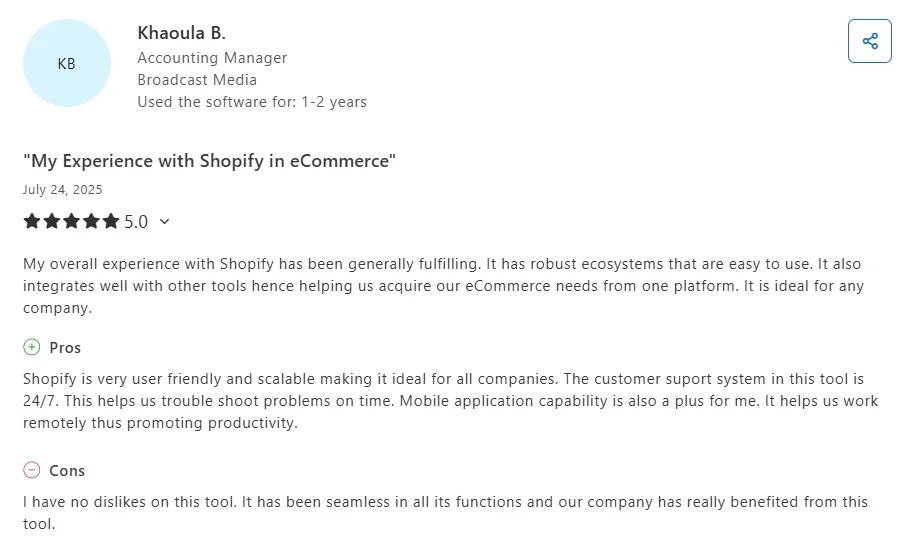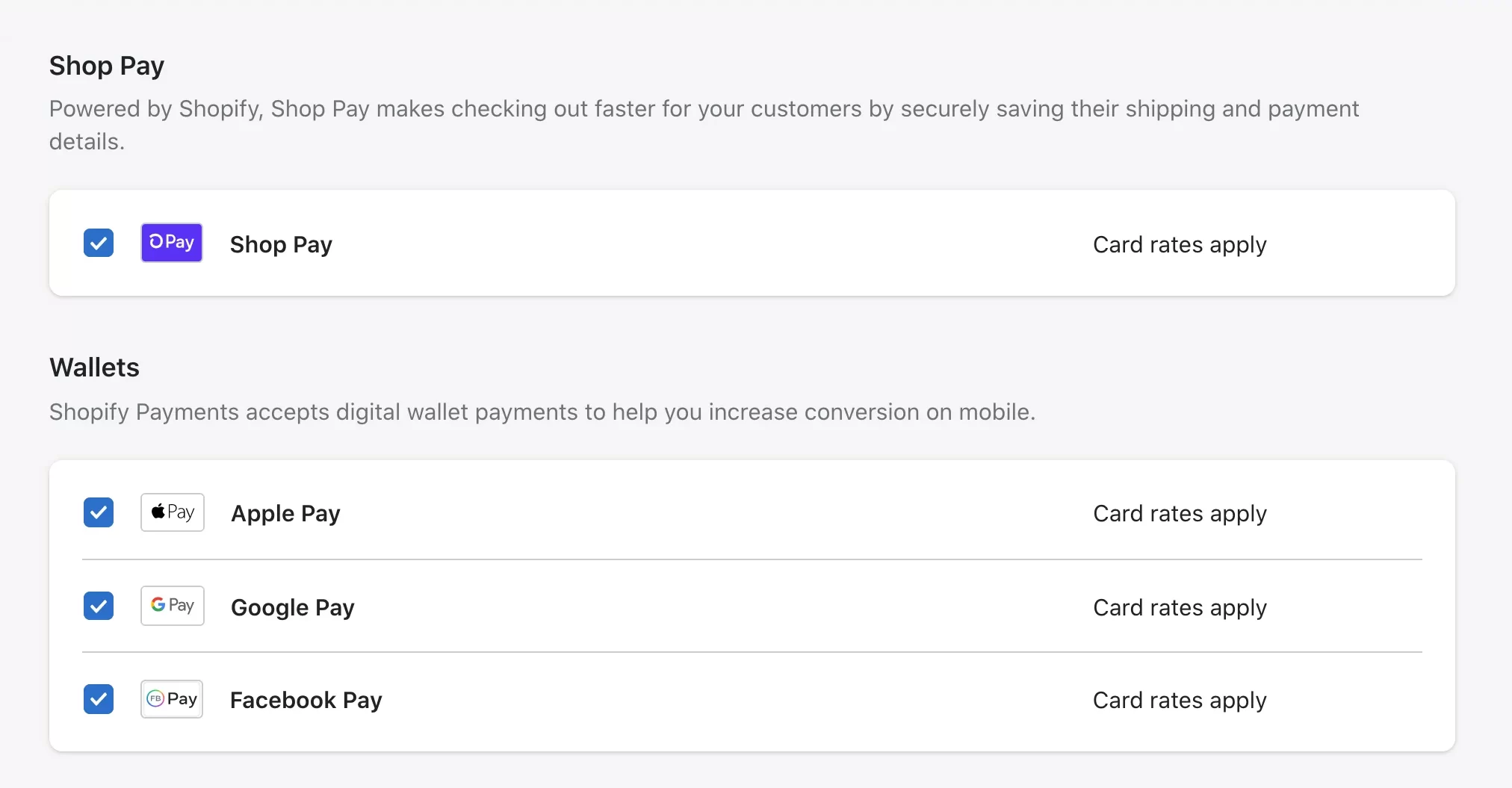Before you launch your store, reading a Shopify review can help you decide if it’s the right fit. Shopify has been thriving since it was founded in 2006. Today, Shopify powers over 4.8 million active stores and serves more than 875 million customers worldwide, with numbers growing every year. Why is it so popular? Its easy drag-and-drop builder, robust eCommerce features, and a massive app ecosystem make it a favorite for businesses of all sizes.
Before writing this review, we spent time building and managing a store on Shopify ourselves, exploring every feature from setup to daily operations. By experiencing the platform firsthand, we’re able to share genuine, unbiased insights to help you truly understand what Shopify offers.
Our Shopify reviews include:
- Is Shopify worth it?
- Brief review of Shopify
- Shopify pros and cons review
- Most essential information of Shopify review (functions, ease of use, how much is Shopify)
Feeling excited? Let’s dive into our honest reviews of Shopify!
In Love with Shopify Already?
LitExtension can help you transfer your data from your current eCommerce platform to a new one accurately and seamlessly with utmost security.
FREE DEMO NOW

📌 Shopify Review: Key Takeaways
- Shopify remains one of the best website builders in 2025 with an overall rating of 4.8/5 for its fast, secure, and highly reliable eCommerce experience.
- Its biggest strength is the beginner-friendly interface and robust performance, while its main drawback is heavy reliance on apps and limited built-in SEO/customization.
- Shopify scores highest in ease of use (5/5), with strong eCommerce features like abandoned-cart recovery and scalable tools for businesses of any size.
- Shopify is ideal for entrepreneurs, small-to-medium businesses, and even growing brands looking for a flexible, all-in-one online selling solution.
- It suits businesses that prioritize simplicity and scalability over deep customization, making it great for those who want to launch and manage stores quickly.
- Shopify’s pricing is considered fair and flexible, offering multiple tiers with core features included, but some advanced tools require higher plans or third-party apps.
Shopify Review – A Quick Verdict
Shopify remains one of the strongest eCommerce platforms in 2025, offering unmatched scalability, a polished user experience, and an enormous app ecosystem. While it’s not the cheapest option, especially once you factor in add-ons, it delivers a well-rounded, reliable solution for businesses of all sizes. Its performance, ease of use, and integrations are top-tier, though SEO depth and built-in marketing capabilities still lag behind specialist tools.
Below is our breakdown of each core category, summarizing our findings and ratings:
Criteria | Feature Breakdown | Our Ratings |
Pricing | Flexible plans starting at competitive rates, but additional costs for apps and themes can add up quickly. | 4.5/5 |
eCommerce Tools | Powerful core features and a huge app store, though advanced features might often require paid plugins. | 5/5 |
Apps & Integrations | 13,000+ plugins available, catering to different needs of users | 5/5 |
Inventory Management | Strong SKU tracking, variants, low-stock alerts, and bulk editing; ideal for growing catalogs. | 5/5 |
POS System | Smooth integration with Shopify stores, hardware options, and real-time syncing for online/offline sales. | 5/5 |
Multi-channel & Omnichannel | Easy integration with Amazon, eBay, social media, and more for centralized sales management. | 5/5 |
Payment & Shipping | Shopify Payments offers smooth checkout and competitive rates; robust shipping tools with flexible delivery options. | 5/5 |
Report & Analytics | Clear sales/traffic insights included; advanced reports require higher-tier plans or apps. | 4.5/5 |
Internationalization | Shopify Markets supports multi-currency, localized domains, and translations for global selling. | 5/5 |
Dropshipping | Fast setup with popular integrations | 5/5 |
Sales Tax | Automated calculations and Avalara integration; limited customization for complex tax rules. | 4/5 |
Ease of Use | User-friendly dashboard and setup process; minimal learning curve for most users. | 5/5 |
Themes & Customization | Professional, responsive templates with good customization options; free theme selection is quite limited. | 4.5/5 |
SEO Features | Covers basics like meta tags and redirects; lacks deeper technical controls without apps. | 3/5 |
Marketing Tools | Built-in email, discount, and recovery tools; falls short for advanced segmentation and automation. | 3.5/5 |
Performance | Excellent uptime and fast loading globally, even under heavy traffic. | 5/5 |
Security | PCI-compliant with SSL, fraud detection, and strong server protection. | 4/5 |
Support | 24/7 across chat, email, and phone; responsiveness is good, though quality varies. | 3/5 |
Is Shopify still good in 2025?
My answer is yes, it is. Shopify is one of the best eCommerce platforms that offers an all-in-one solution for e-merchants. It is fully packed with powerful selling features, well-designed website templates, and an easy-to-use interface. Therefore, you can quickly create an online store and start selling on Shopify.
With flexible Shopify pricing plans, the Shopify store builder can cater to the needs of businesses of all sizes. Whether you’ve just started or are currently looking for B2B eCommerce software to expand your store, Shopify can always come up with the right solution for you.
With that being said, every coin has its flip side, and this platform is not an exception. Shopify eCommerce still has some fine print that you should take into consideration. First, though the platform comes with free Shopify themes, the selection is quite limited. Additionally, in some cases, you might need to integrate with other apps and plug-ins to enhance your business capability. This is another Shopify con that you shouldn't ignore.
To learn more about the pros and cons of Shopify and how we think about it, please keep on reading and find your answer to the question, “Is Shopify Worth It?”
Shopify Pros and Cons
Before getting to the details of Shopify review, here are all the Shopify pros and cons that we have summarized after months of working with this platform.
Shopify Pros | Shopify Cons |
✓ Easy to use with a simple dashboard | - Requires extra transaction fee if merchants don't use Shopify Payments |
✓ Wide selection of themes | - Limited customization function |
✓ Fully responsive and mobile-friendly website templates | - Limited selection of free Shopify themes |
✓ Integrable with thousands of third-party extensions on the Shopify App Store | - Adding extra functions or custom fields might be complicated |
✓ Powerful eCommerce features | - Some reports are available on higher pricing plans only |
✓ Abandoned cart saving available on every Shopify pricing plan | - Basic blogging features |
✓ Smooth and frictionless Shopify checkout with Shop Pay and Shopify Payments | - No email hosting |
✓ Great internationalization options | - Requires Shopify Payments or Shopify Markets to sell in multiple currencies |
✓ Massive discount when purchasing an annual Shopify pricing plan | - Phone support is available in a few language only |
✓ High loading speed | |
✓ High level of security | |
✓ 24/7 support |
If you are tired of reading these walls of text, check out our visual Shopify review (which we've continued testing over the years) below to catch all the pros and cons of Shopify. Besides, it will provide a quick overview of what Shopify is, how Shopify works, and why choose Shopify.
✍️ Honest customer reviews of Shopify
Still in doubt whether Shopify is worth it? Why don't we take a look at Shopify from credible sources (TrustPilot and G2), written by merchants who have been using this platform?
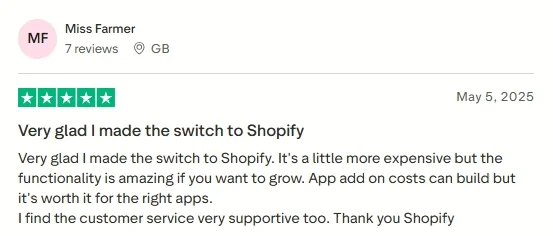
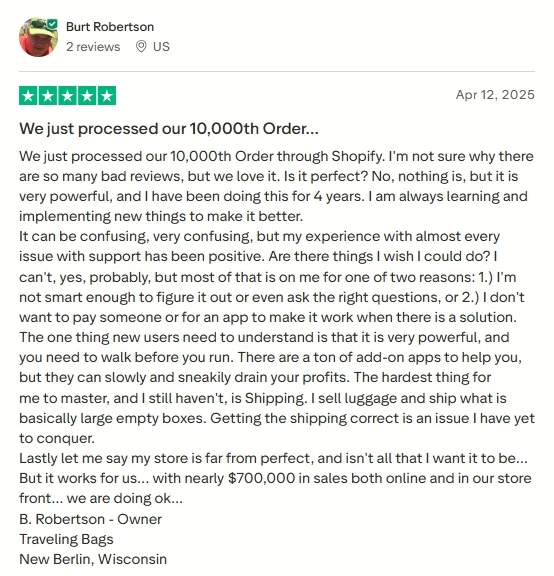
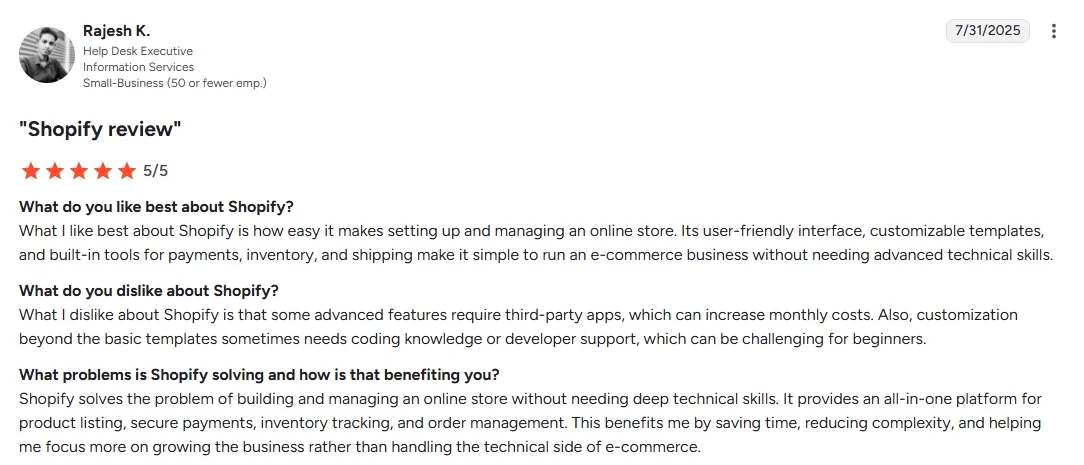
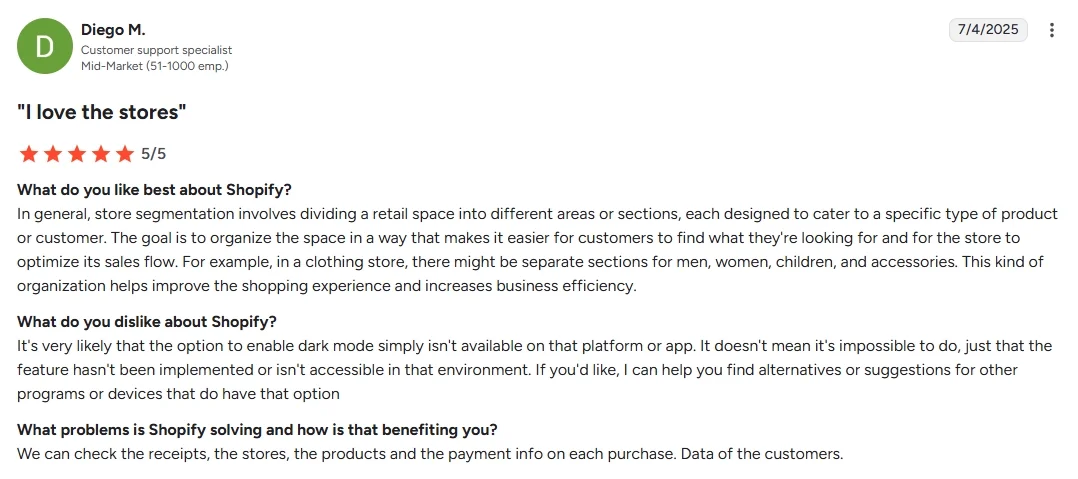
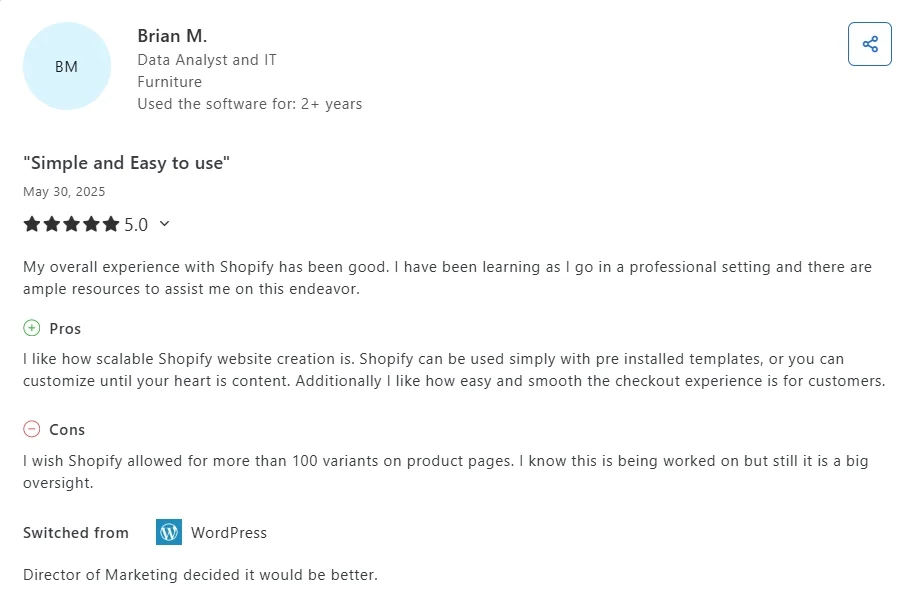
Shopify pricing: Flexible plans with added costs for extras (4.5 out of 5)
⭐ Our Rating: 4.5/5
offers a scalable and transparent pricing model that works for solo entrepreneurs, growing brands, and enterprise-level stores alike. However, it is totally cost-effective once your business reaches potential growth with the help of powerful tools from Shopify.
💡 Our thoughts on Shopify pricing:
Overall, while Shopify’s pricing structure is fair and competitive, especially when compared to other major eCommerce platforms, users should be prepared for the cumulative cost of apps and add-ons, especially if they want a fully customized experience.
The SaaS eCommerce platform offers you 3 plans with monthly costs:
- Firstly, let’s take a look at the Basic Shopify plan. With $39 per month, you get all the basic eCommerce functions. If you’ve just started your business or just want to build a simple online storefront for your existing brick-and-mortar one, this is a suitable option.
- The next plan, Groow, costs $105 and has everything you need for a growing business. Paying such an amount provides you with additional benefits, like superior reports and lower fees regarding third-party transactions and credit card rates.
- Advanced Shopify costs $399 monthly and comes with the most advanced features. This plan makes the process of operating a large eCommerce business more effortless. You will get all the best features of the two previous plans plus some exclusive benefits like custom reports, the lowest fees (third-party transaction, shipping, and credit card rate), tax and duties calculation at the checkout step.
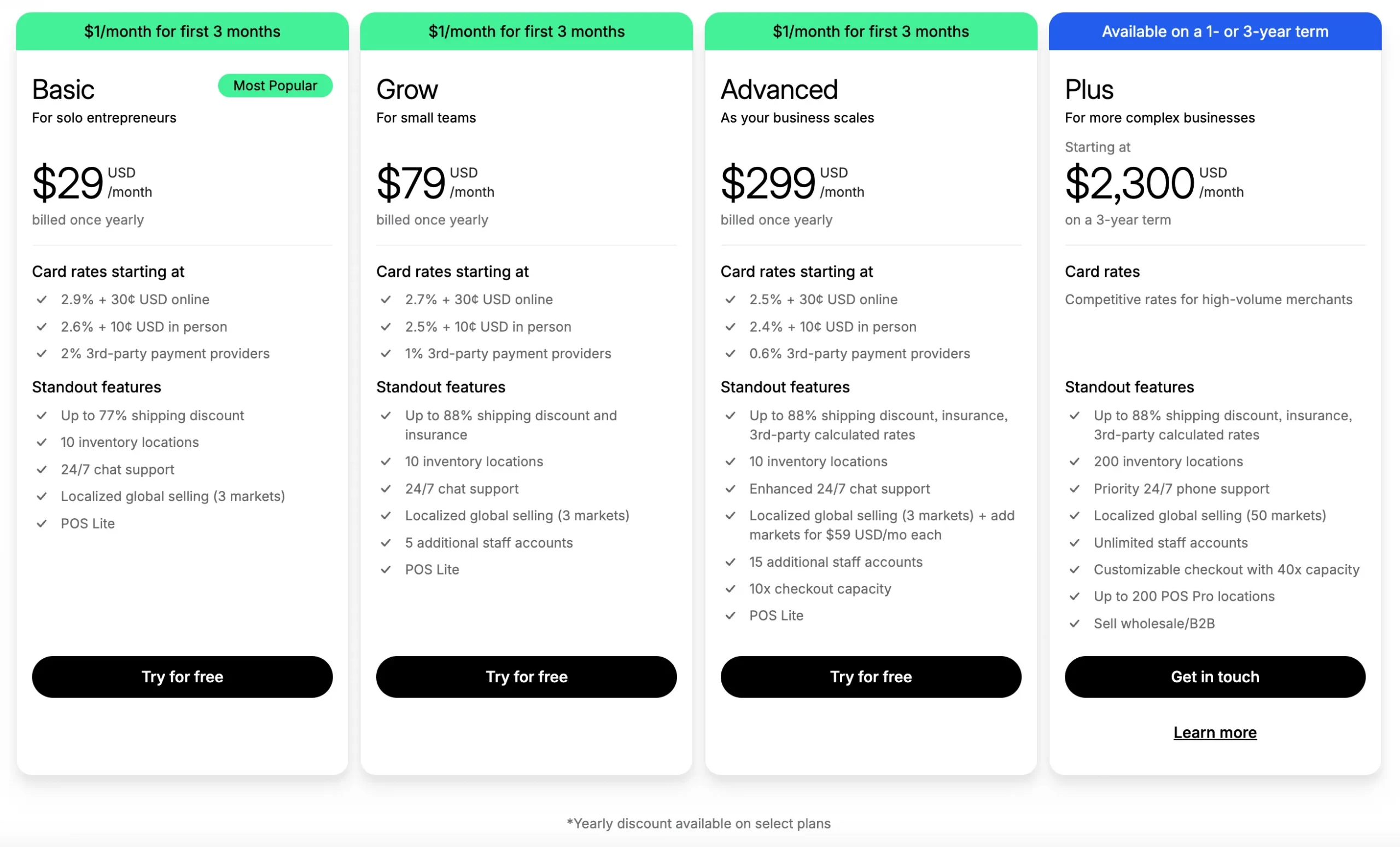
From our perspective, we recommend the Shopify or Advanced Shopify plan. These plans provide users with advantages regarding lower transaction fees, more staff accounts, more inventory locations, a professional report system, and an automatic workflow.
Since your orders rocket and your business grows, you will have to pay more transaction fees. Then, the higher the Shopify plan is, the more cost related to credit card rates and transaction fees can be saved.
In particular, if you decide to use any payment provider other than Shopify Payments, the additional fee per transaction will be 2.0%, 1.0%, and 0.5% for Shopify Basic, Shopify, and Advanced Shopify, respectively. When it comes to the online credit card rate per transaction, you can also save some pennies with a higher Shopify plan.
- Basic Shopify: $2.9 + 30 cents.
- Shopify: $2.6 + 30 cents.
- Advanced Shopify: $2.4 + 30 cents.
✅ Other Shopify pricing plans
Along with the main pricing plans, Shopify helps you save a lot of time and cost in selling online with Shopify Starter. This plan allows you to effortlessly distribute your products/services without having to build up a complete store. It only costs you $5 per month.
Besides the aforementioned Shopify fees, Shopify also has the “cream of the crop” version that is tailor-made for enterprise-level businesses, named Shopify Plus. If you want to explore other expenses for launching and managing your Shopify store, check out this detailed Shopify pricing article from us.
Shopify ease of use: Simple and intuitive after quick setup (5 out of 5)
⭐ Our Rating: 5/5
While conducting this Shopify review, we asked several staff with different technical backgrounds to test out this platform, and none of them had trouble building a Shopify website. The setup process is just a breeze; everything is laid out nicely and logically, so we didn't get lost for once during our time writing this assessment.
💡 Our quick verdict:
Shopify delivers one of the smoothest user experiences in the eCommerce space. From the moment you sign up, the platform guides you through store setup with a clear, beginner-friendly onboarding process. The dashboard is clean, logically organized, and easy to navigate, even for users with no technical background.
When it comes to user-friendliness, we don't hesitate to give this platform a high score. Shopify is surely one of the easiest platforms to get started with. It’s designed for everyone, especially beginners, to kick-start their eCommerce businesses efficiently.
If you would like to check out how user-friendly Shopify is, you can try the platform for free now. This Shopify tutorial video can help you quickly set up your Shopify store:
If you want to visualize all the steps needed to start a Shopify store, here's a brief guide that we have compiled.
First, you will need to create a Shopify account. After filling in your email address, a password for your account, and a name to begin, Shopify takes you to the initial configurations.
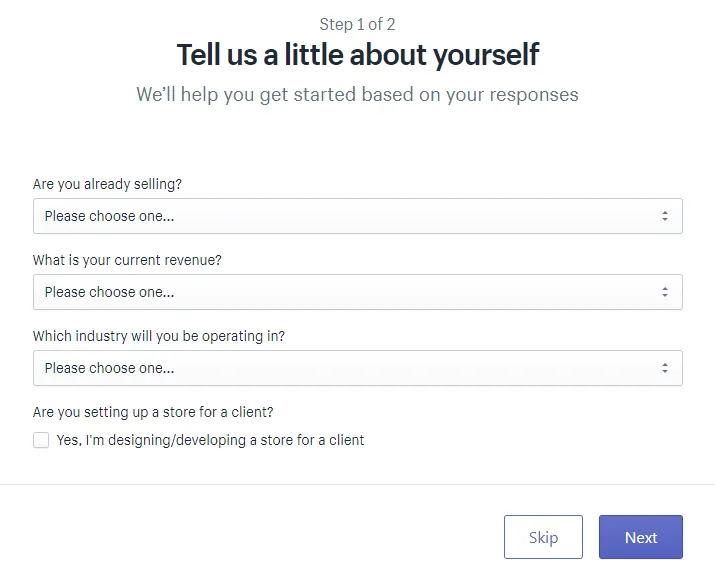
The main page shows the shortcuts to add the first products, customize your Shopify theme, and add a new domain or transfer the Shopify domain if you already have one. Furthermore, in case you cannot come up with an idea for your website address, just find inspiration from the Shopify domain name generator tool.
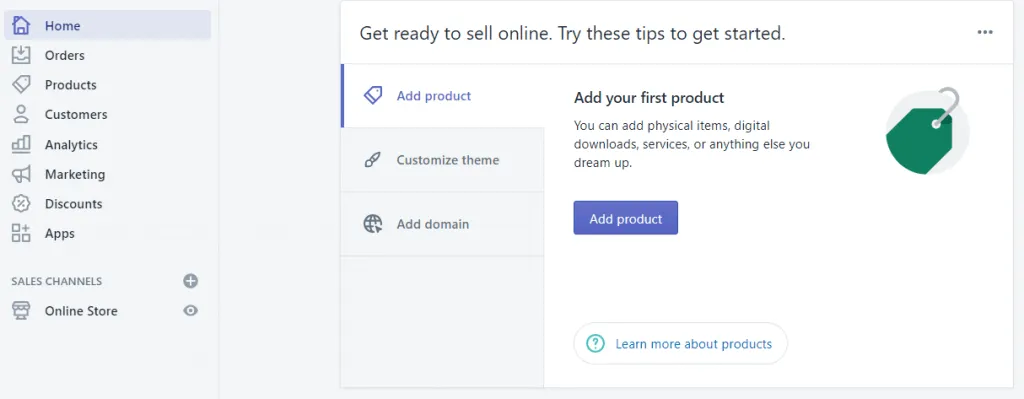
As seen from the image, the dashboard is straightforward, with categories containing corresponding sub-sections for easy navigation. You can easily import products to Shopify, add some finishing touches, and your store will be ready to go live.
Shopify eCommerce tools: Strong features but app-reliant (5 out of 5)
⭐ Our Rating: 5/5
In this Shopify review, the platform earns a solid 5 out of 5 for its eCommerce toolkit thanks to its broad set of native selling features and an unmatched third-party app ecosystem. That said, while the toolkit is powerful, some advanced features require additional paid apps. This means the platform is extremely flexible, but often at the expense of a higher monthly cost.
💡 Our quick verdict
Shopify provides everything most merchants need to start, run, and grow an online store, all within a clean, centralized dashboard. Its strength lies in versatility; merchants can begin with the solid native toolkit and add advanced capabilities through apps as their business expands. This flexibility ensures Shopify can serve both small startups and large, complex operations, but it also means that businesses with highly specialized needs will likely spend extra on app subscriptions.
#1 Vast options with 13,000+ plugins on Shopify App Store (5 out of 5)
⭐ Our Rating: 5/5
Shopify’s App Store is one of the largest in the eCommerce world, with over 13,000 plugins covering everything from marketing automation and SEO to dropshipping, accounting, and customer support. That's why it earns a solid 5 out of 5 in this Shopify review.
💡 Our quick verdict:
Overall, the Shopify App Store is a valuable asset you don't want to miss; its 13,000+ apps cover basically every need! Sections like “Staff Picks” or “Popular with merchants” also make it very easy for beginners to navigate through collections.
Shopify comes with the top eCommerce app store in the market, offering an impressive collection of 13,000+ plugins on its Shopify App Store and which is greater than many other hosted solutions. On top of that, this eCommerce platform has carefully evaluated each app to guarantee its seamless operation without slowing down your store's speed.
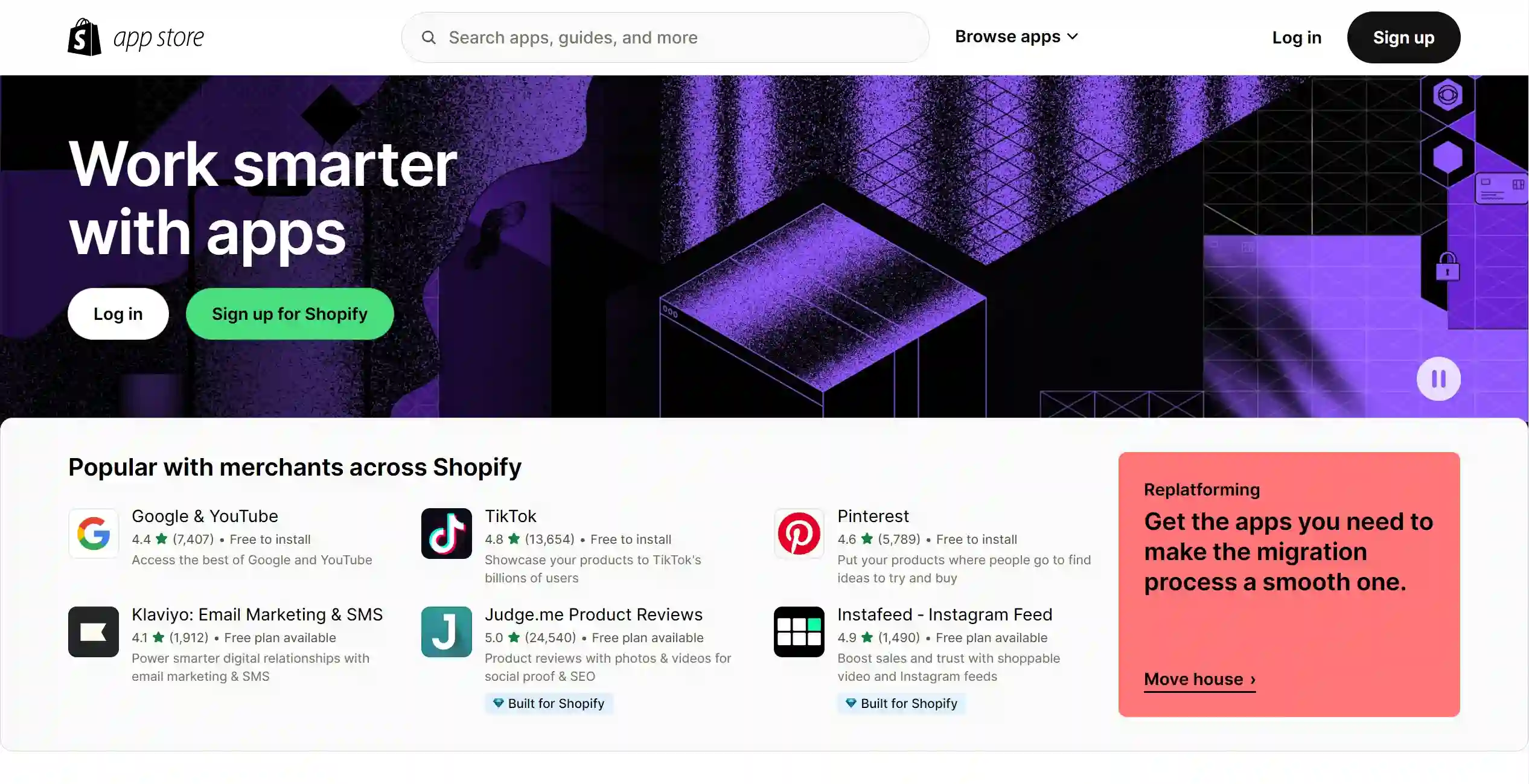
While Shopify has already included most of the functionalities to meet basic needs, the App Store breaks all limits to what you can make of your eCommerce site.
As far as we analyze and review, the Shopify team does a good job helping you navigate through the enormous store by letting you browse by categories or collections. They are even passionate enough to create a “Staff picks” section containing apps personally selected by the team themselves.
Other than that, you can browse the app store for more marketing tools, order & inventory management, store design tools, more. Some apps let you connect to social media platforms in order to promote your business further and increase traffic to your site.
#2 Smooth and powerful inventory management (5 out of 5)
⭐ Our Rating: 5/5
Shopify scores a perfect 5 out of 5 for inventory management thanks to its intuitive interface, real-time tracking, and robust control over product data.
💡 Our quick verdict:
Shopify’s inventory management tools are powerful yet beginner-friendly, making them a standout feature for both small and large stores. The system handles complex needs without slowing down day-to-day operations. For merchants who want efficiency, accuracy, and scalability, Shopify’s inventory management is one of the best in the eCommerce space.
Next on our review is Shopify inventory management. Shopify lets you manually add products or import them using CSV files. Additionally, customers, orders, and other pieces of data can also be imported.
Adding products is extremely simple. Clicking on “Products” right in the main dashboard directs you to the page where you can manage your products. If you haven’t had any, Shopify will show a big button right in the middle to add one.
You can fill in all the information related to your products, including titles, descriptions, featured images, videos, and so on. SKUs and quantity tracking features help manage your inventory efficiently and automatically mark out-of-stock products.
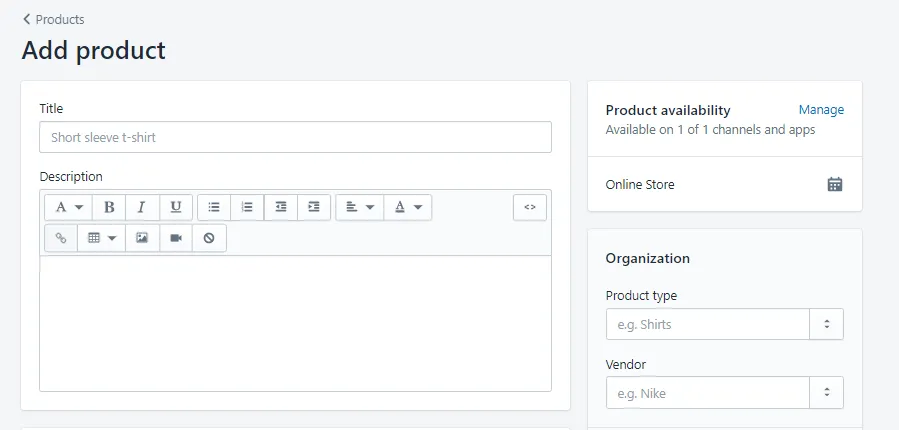
Here you can also add variations for your products and set different prices for each one. However, note that you can only add 3 variants (size, color, material, etc).
#3 Seamless online-to-offline selling with Shopify POS
⭐ Our Rating: 5/5
Shopify’s Point of Sale (POS) system earns a perfect 5 out of 5 for its seamless integration with online stores and its ability to unify sales, inventory, and customer data across multiple channels.
💡 Our quick verdict:
Shopify POS bridges the gap between online and offline commerce better than almost any other eCommerce platform. Merchants can manage in-person sales, process returns, and access customer profiles from the same system they use for their online store. This unified approach eliminates inventory discrepancies, speeds up checkout, and provides a more consistent shopping experience for customers.
A point of sale (POS) is a physical place where a customer purchases goods or services. A POS transaction may occur in person or online, with receipts generated either in print or electronically.
Shopify POS is an application for iOS and Android devices that you can use for transactions in a brick-and-mortar store, markets, or a pop-up setting. Find products, process orders, take payment, swipe credit cards, produce receipts, and control it all from your iPad or mobile device.
Currently, there are 2 Shopify POS subscription plans for you to choose from: Shopify POS Lite and Shopify POS Pro, with a bunch of unique features.
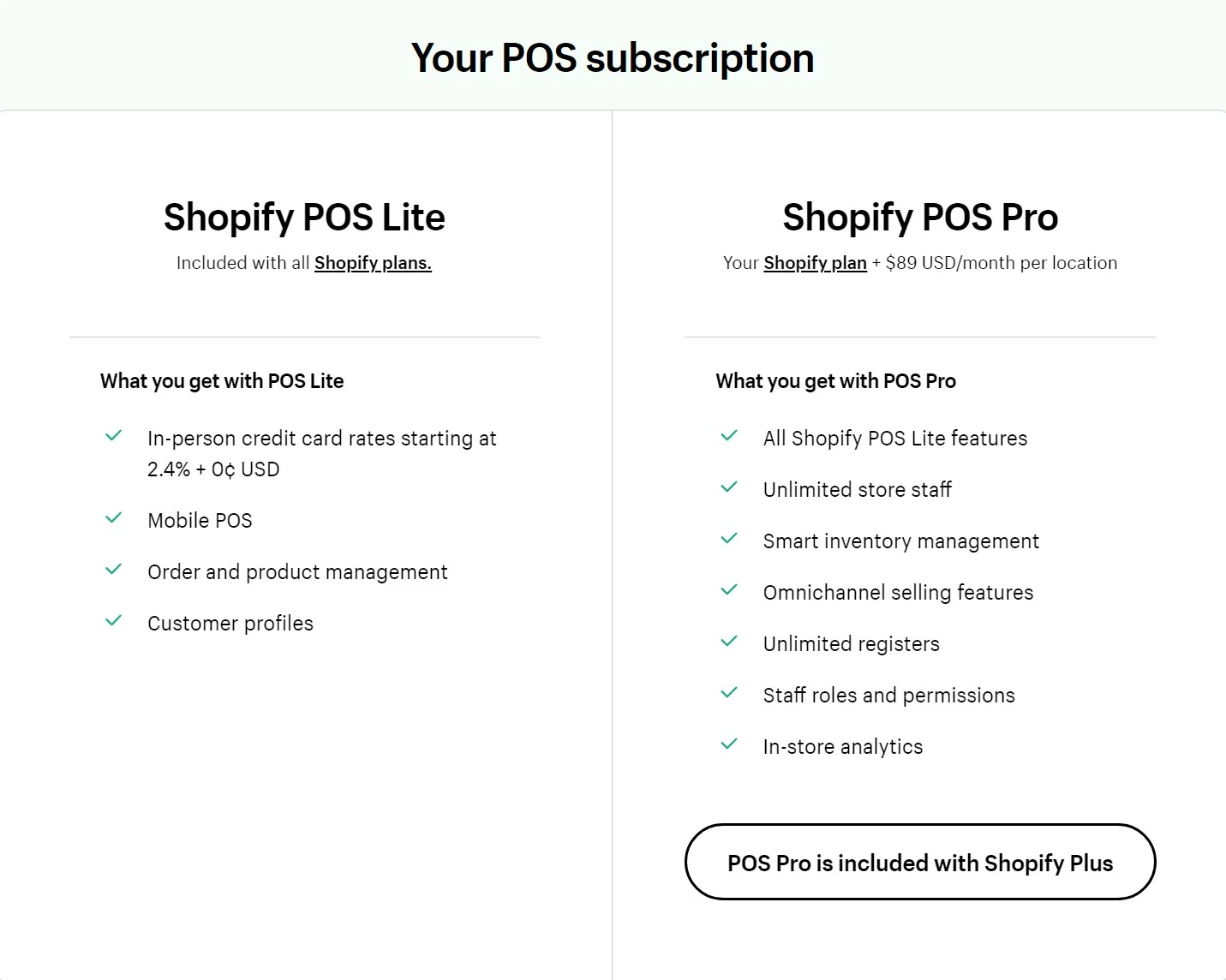
I can say Shopify POS is your ultimate toolkit for combining online and offline sales. The extensive features (issuing receipts, processing payments, finding products, and more) let you sell basically everywhere with ease!
#4 Multi-channel & omnichannel: Easy to expand sales across platforms (5 out of 5)
⭐ Our Rating: 5/5
Shopify earns a perfect 5 out of 5 for its multi-channel and omnichannel selling features. The platform makes it easy for a business to connect its store with popular marketplaces like Amazon and eBay, as well as social media channels like Facebook, Instagram, and TikTok.
💡 Our quick verdict:
In this Shopify review, the multi-channel and omnichannel tools stand out as a major strength. Merchants can list products on multiple sales channels at the same time, while Shopify automatically updates stock levels and orders. This connected approach not only saves time but also helps a business reach more buyers without adding extra complexity.
1. Social commerce
Social commerce uses social networking websites such as Facebook, Instagram, and Messenger as vehicles to promote and sell products or services.
According to Forbes, 30% of consumers now say they’d purchase social media. Therefore, this sales channel is an effective way to approach customers and boost your sales. You can connect Shopify to Facebook, Instagram, or even Messenger.
Sale Channels | Supports from Shopify |
Facebook and Instagram | - Sync your products to a catalog on Facebook and Facebook Shop - Allow you to create and manage Marketing and Ads campaigns on Shopify - Let you run Ads retargeting |
Messenger | - Allow your customer to shop directly from the conversation - Add the “Contact Us” button to your store - Bring you the ability to customize your automated messages |
2. Marketplaces integration
Besides Social media and POS, in this review, we will mention the integration of Shopify with marketplaces.
Shopify also allows merchants to connect with some of the best eCommerce platforms and marketplaces around the world, such as Amazon or Handshake (available in the US).
Shopify Amazon Integration
- Link Shopify to your existing Amazon listings or create a new list on your Amazon store.
- Link your existing Amazon listings to your Shopify admin.
- Manage everything from your Shopify Admin panel.
Wholesale channel (only available for Shopify Plus)
- Create a separate, password-protected storefront for Wholesale.
- Add wholesale-only products that are available in your wholesale store only.
- Manage everything from your Shopify Admin panel.
Please note that you can still integrate your Shopify store with other markets by using an extension or a third-party developer.
#5 Shopify payment & shipping: Smooth checkout with flexible delivery choices (5 out of 5)
⭐ Our Rating: 5/5
Shopify earns a full 5 out of 5 for its payment and shipping tools because it offers a wide range of secure, reliable, and fast options.
💡 Our quick verdict:
In this Shopify review, the payment and shipping features prove to be both flexible and reliable. A merchant can set up payment methods quickly, offer multiple secure checkout options, and manage shipping from the same dashboard.
Shopify offers over 100 payment processors (probably more than any other platform), including the most popular names such as Stripe, 2Checkout, PayPal or Authorize.
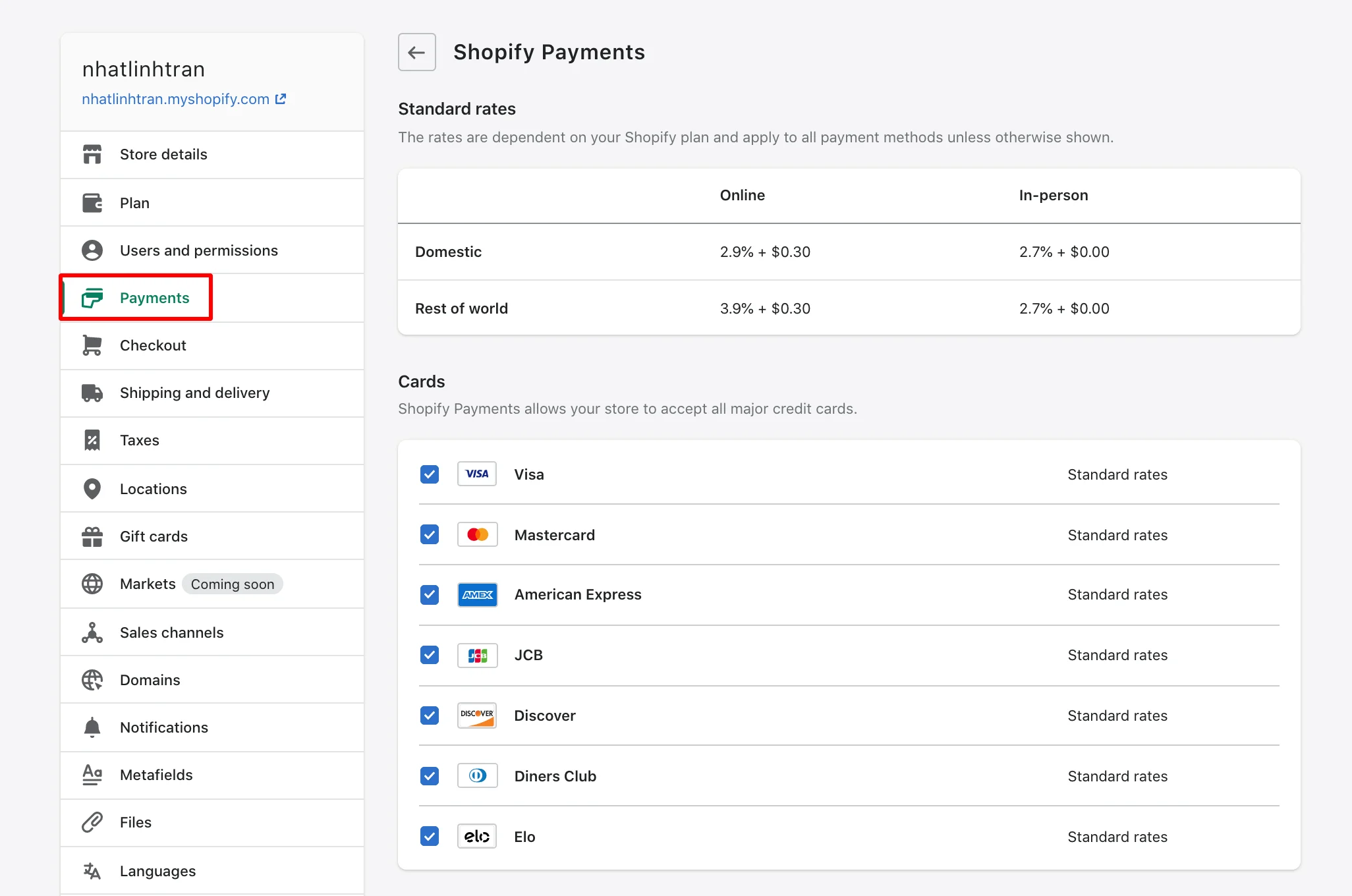
This is great news, except for the fact that Shopify will charge you a transaction fee (2.5% to 0.5% depending on your plan) unless you use its own payment gateway – Shopify Payments.
The option of accepting payment in multiple currencies is only available with Shopify Payments. The system will automatically convert the price according to current exchange rates. You should definitely consider this option if your target market expands overseas and your location is on the list of where Shopify Payments is available.
Besides, opting for Shopify Payments also opens the door for an accelerated checkout function, Shop Pay. To learn more about this built-in feature, please take a look at our Shop Pay review for more.
We have no doubt that Shopify provides high flexibility when it comes to shipping review. You can configure your shipping rates (free shipping, flat rate, depending on region, etc).
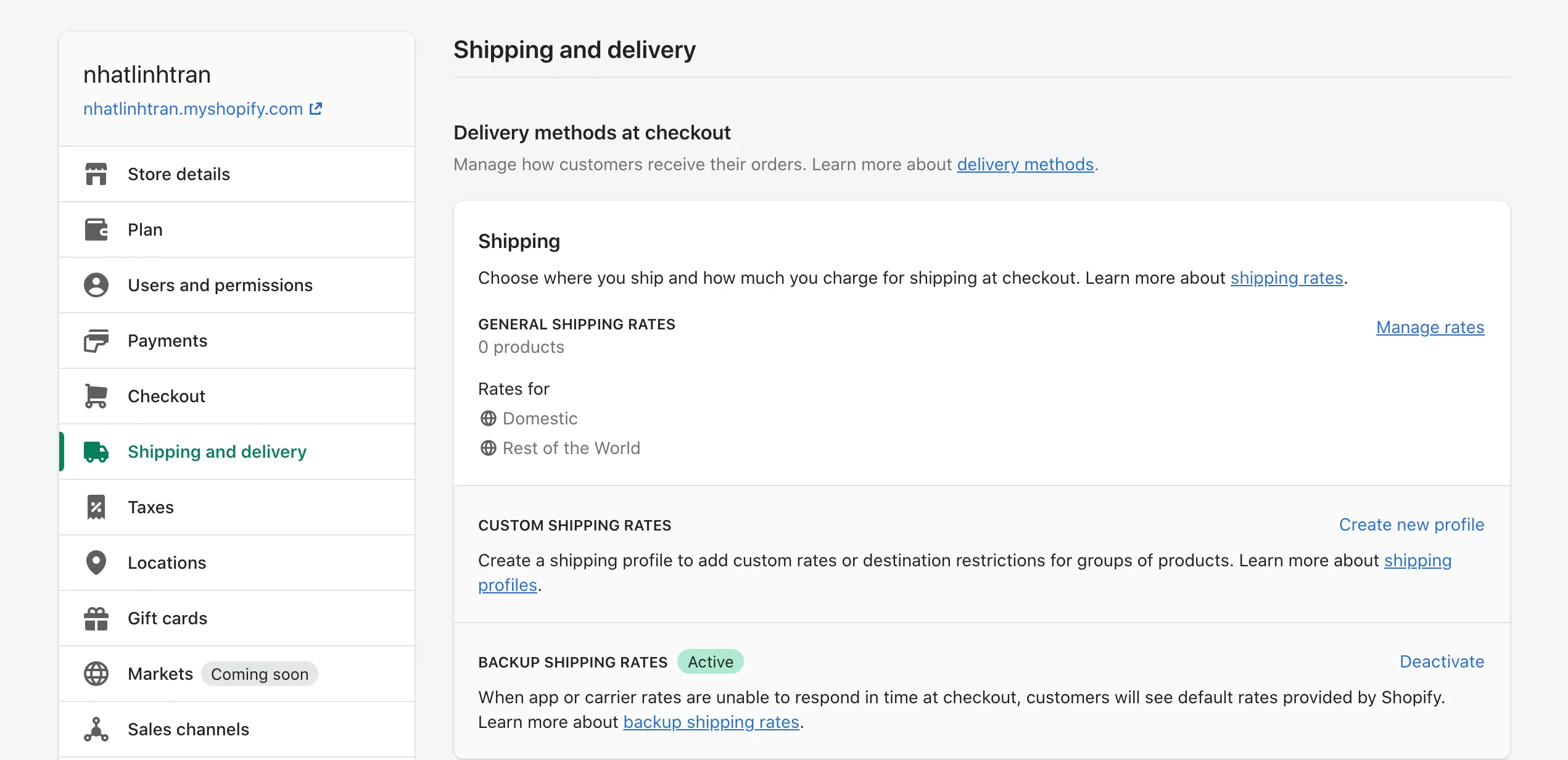
With the Advanced Shopify plan, you can also unlock the third-party calculated shipping rates, showing customers the current courier prices at checkout.
With over 100+ payment processors supported (plus Shopify Payments), you have got plenty of flexibility here! Shipping is just as customizable as you can easily choose between free shipping, flat rates, or region-based rates. All in all, it's an amazing setup for businesses with a strong focus on both local and international customers alike.
#6 Shopify reporting & analytics: Clear insights, advanced data at extra cost (4.5 out of 5)
⭐ Our Rating: 4.5/5
In this Shopify review, the platform earns 4.5 out of 5 for its reporting and analytics, as it provides accurate and easy-to-read data that helps merchants understand their store performance. The platform includes basic reports on sales, traffic, and customer behavior across all plans, which are updated in real-time.
💡 Our quick verdict:
From my point of view, reporting and analytics stand out as a strong yet slightly tier-restricted feature. You can track key metrics from the moment it launches, making it easier to see what is working and what needs improvement. However, businesses that want more advanced analytics will need to invest in a higher plan or third-party tools, which can increase monthly costs.
Shopify offers a decent range of reporting tools, which can be upgraded with higher plans.
Basic Shopify gives you a real-time overview of Shopify store analysis, such as revenue, consumer preferences, etc. Further upgrades include detailed sales and customer reports, and Advanced Shopify or Shopify Plus both provide deep analysis with the help of filters.
Our analysis of the product leads us to believe that you can also benefit quite a lot from Google Analytics integration. Connecting your store to a Google Analytics account results in an adequate and flexible combination between the two, where you may find almost anything you need.
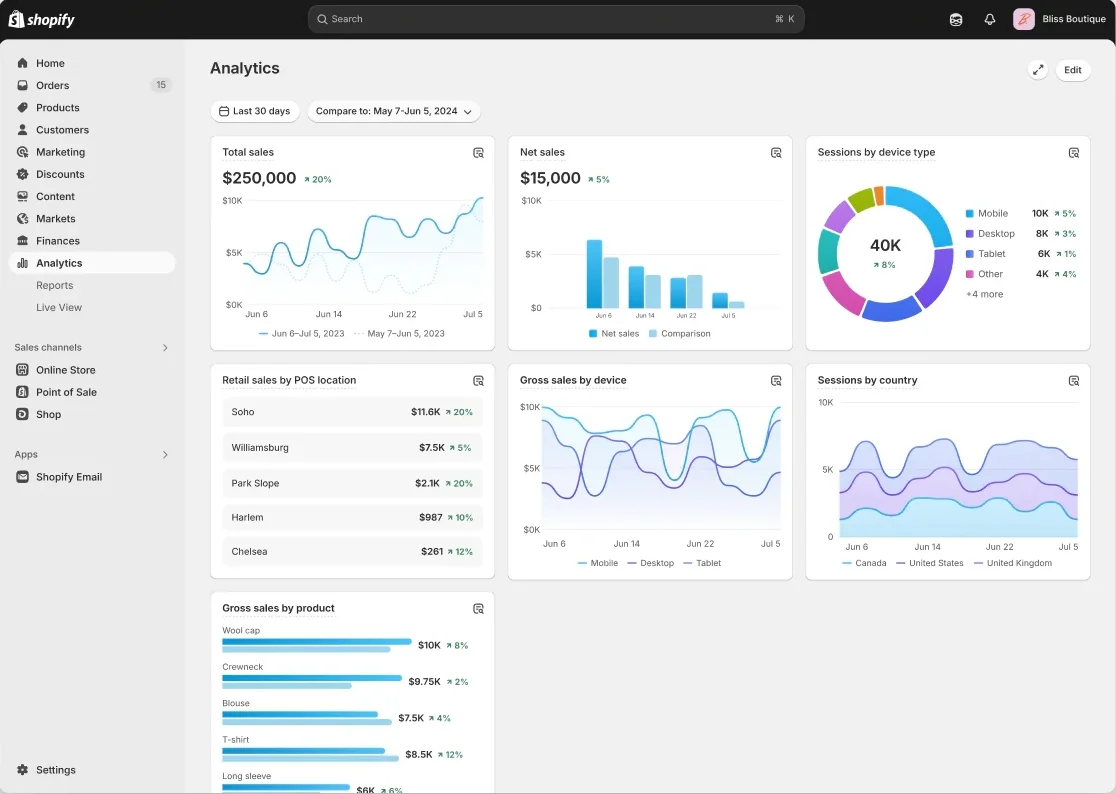
The new function aims to support multi-channel businesses. It allows you to see an overview of critical metrics for all your stores in one central place. Hence, you can easily monitor the health of your business as well as grab the big picture of “What’s happening right now” for all of your channels.
If you're aiming to optimize every aspect of your business, Shopify's analytics will be an excellent assistant here. After all, real-time store insights are available even on the Basic plan! And as you move to higher plans, the analytics deepen to cover detailed sales, customer behavior, and even cross-channel performance.
#7 Shopify internationalization: Strong global selling with Shopify Markets (5 out of 5)
⭐ Our Rating: 5/5
We give Shopify’s internationalization tools a full 5 out of 5 because they offer a complete and user-friendly solution for selling across borders. The ability to display local currencies, support multiple languages, and manage international domains from a single dashboard makes global expansion much easier, even for beginners.
💡 Our quick verdict:
Shopify Markets makes global selling fast, simple, and effective, even for small stores. Its built-in features for currency, language, tax, and local domains mean you can sell worldwide without needing outside tools.
Shopify is a strong candidate if your priority is cross-border selling, so you can reach customers all around the world. It allows your store to connect with various sales channels, enable multiple languages, multiple currencies, and location-based tax settings so you can create a localized shopping experience for your visitors.
1. Multi-languages
Shopify's Multi-languages function lets you create separate URLs for your original content in a different language.
When customers land on a translated URL, your website will automatically show the translated version. After that, your customer can view the product, create an order, checkout, and receive notifications in their local language.
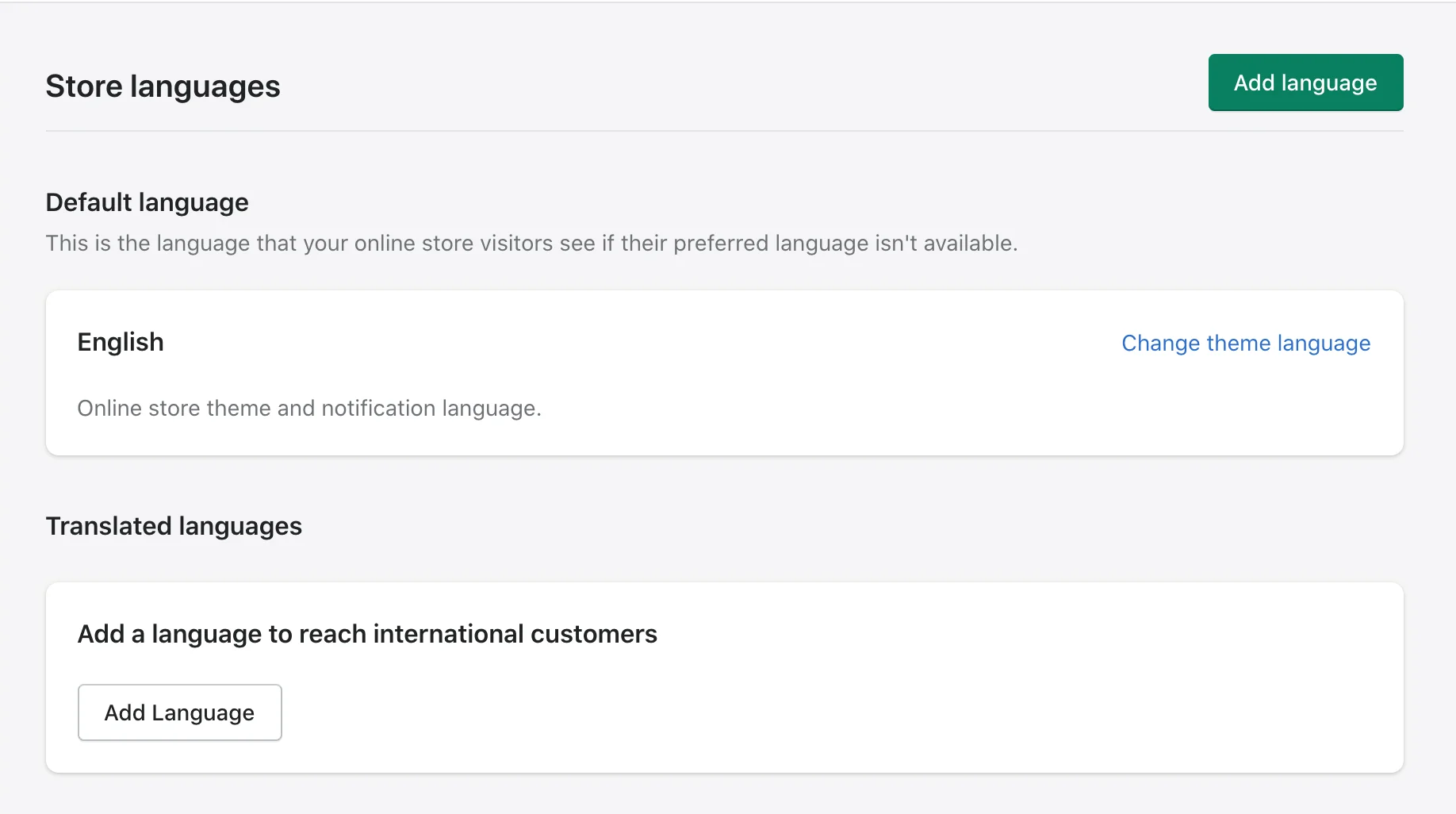
The number of available languages depends on your current Shopify plan:
- Basic Shopify, Shopify, Advanced Shopify, then you can translate up to 05 languages
- Shopify Plus merchant, then you can translate your store into 20 languages
2. Currencies
Selling with multiple currencies is also supported by Shopify. When applying this function, your customers can view prices in your store, pay for their orders at checkout, and receive refunds in their local currency.
The conversion rate is set up by default based on the real-time foreign exchange rate. If you want to change the currency, you can lock in a fixed rate for each currency manually.
Note: Selling in multiple currencies is only supported by Shopify Payments. Orders placed using PayPal or other third-party payment providers are processed in your store currency.
3. Tax settings
Tax is also an obstacle when you want to sell internationally. Fortunately, Shopify has it covered for your business.
Many countries charge taxes based on an order's destination. Therefore, you can set up these rates manually (more on this below).

Shopify's multi-language support, diverse currencies, and location-based tax rates make cross-border selling easier than ever. I highly recommend this feature if you want to create a truly global shopping experience that resonates.
#8 Shopify dropshipping: Fast setup with popular app integrations (5 out of 5)
⭐ Our Rating: 5/5
We give Shopify a perfect 5 out of 5 for dropshipping capabilities because it offers one of the smoothest and fastest setups available. The platform is built to support automation, scalability, and speed, three essentials for a successful dropshipping operation in 2025.
💡 Our quick verdict:
I must say that Shopify is one of the best platforms for starting and growing a dropshipping store. Its seamless app integrations, user-friendly setup, and flexible order fulfillment make it ideal for beginners and experienced sellers alike. You can connect to thousands of suppliers, import products in minutes, and automate most of your workflow—all without writing a single line of code.
Although dropshipping is a newcomer in the market, it has quickly become one of the most famous business models at the moment. It allows store owners to sell a product to a customer through a supplier without holding the inventory.
You can control the purchase price displayed on your Shopify store while making profits by paying the wholesale price to the supplier.
Since Shopify is a powerful eCommerce platform, it's definitely an ideal place to kickstart your dropshipping business.
IN short, Shopify is an ideal platform for dropshipping. Most users (even beginners) find it easy to set up their dropshipping business, control the retail price, and have suppliers handle the inventory and shipping. Expansion is also a breeze now that there's no more warehousing hassle.
#9 Shopify sales tax: Automated calculations but limited customization (4 out of 5)
⭐ Our Rating: 4/5
We rate Shopify’s sales tax tools 4 out of 5 because they handle basic tax needs very well, especially for U.S., Canadian, and EU-based businesses. For most sellers, it works great out of the box, but advanced users may need to rely on third-party tax apps to meet specific needs.
💡 Our quick verdict:
Shopify makes sales tax easy to manage for most online stores. Its built-in automation calculates taxes at checkout and keeps rates updated by region. This reduces errors and helps stores stay compliant in key markets. However, businesses with complex tax rules or those selling across multiple countries may find the default setup a bit too basic.
Sometimes, store owners may need to charge tax for some specific types of products on their online business. However, one difficulty is that tax laws and regulations are flexible; they can change depending on your country and religion.
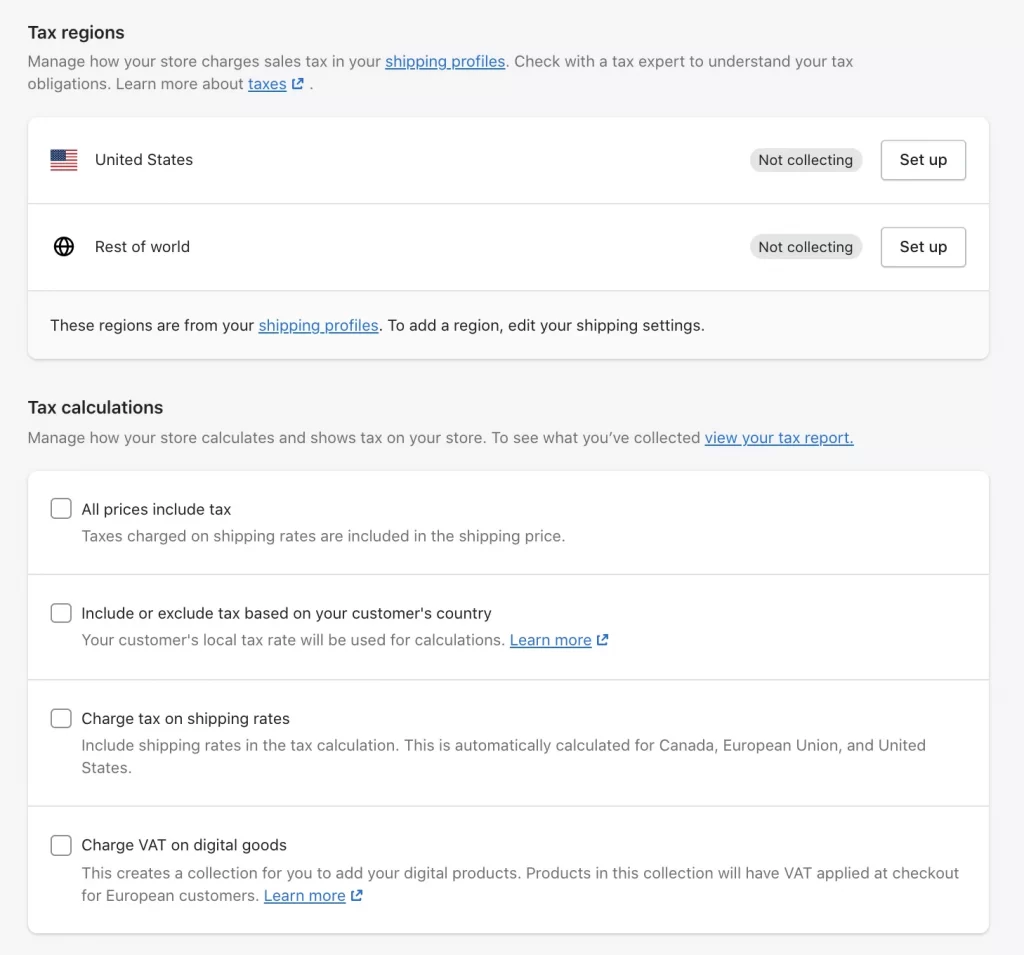
Shopify will handle your problem with an automatic sales tax calculation. You can also set up tax overrides to address unique tax laws and situations.
However, this eCommerce platform won't help you file or remit your sales taxes. You might need to register your business with your local or federal tax authority to have them handle it. Check Shopify sales tax off your to-do list with our super digestible guide!
Overall, there's still one minor hitch since Shopify doesn't handle filing and remitting taxes. Nevertheless, this feature does reduce a significant amount of manual work at the end of the day – highly recommended if you want to keep your store running both smoothly and legally.
If you are asking us, is Shopify worth it in terms of eCommerce features? The answer will be “Of course”. This platform comes off the bat with powerful built-in features, along with great integration ability with thousands of third-party apps. In short, business owners can quickly set up and sell effectively on Shopify.
Beyond third-party apps, Shopify is developing built-in AI features to support merchants and streamline everyday tasks. Our eBook breaks down how these AI tools work and what they mean for your store operations.
Shopify themes: A large collection of modern design (5 out of 5)
⭐ Our Rating: 5/5
In this Shopify review, the platform scores a perfect 5 out of 5 for its theme quality and design flexibility. All available Shopify themes, whether free or paid, are mobile-responsive, optimized for performance, and built with modern eCommerce best practices in mind.
💡 Our quick verdict
Shopify’s themes combine modern design with business-ready functionality, making it easy to create a professional-looking store without hiring a designer. The templates are mobile-optimized, fast-loading, and tailored to a variety of industries, ensuring your store looks sharp on any device.
Although the limited selection of free themes might push some users toward premium options, the investment often pays off in a polished, high-converting storefront.
If you are running on a tight budget or simply not ready for investment, feel free to choose from 20+ Shopify free themes to test out the water. These website templates are minimal, easy to use, and can help you save some money when first starting your business.

Since you will be confused when it comes to picking a proper theme, Shopify allows you to test their templates for an unlimited time. Particularly, you only need to start the Shopify free trial and choose a theme from the Shopify theme store.
Having said that, we still recommend switching to a nicely designed paid theme later on when your business generates a decent amount of revenue. The price may be a bit higher for new businesses, but it’s not that expensive when you consider it as a one-time payment. Furthermore, the paid themes are designed by UI-UX professionals. Hence, you can expect to get excellent quality as well as highly customizable templates for your store.

Note that all themes are freely customizable with the Liquid code. You can add a personal touch to any of the themes by changing colors, fonts, social media buttons, and more. Once again, Shopify’s ease of use makes things much more convenient as you can add, remove, or move sections by yourself with just a few clicks.
Shopify SEO & marketing: Basic built-in tools, limited depth (3.5 out of 5)
#1 Shopify SEO: Basic optimization with limited technical flexibility (3 out of 5)
⭐ Our Rating: 3/5
In terms of SEO tools, Shopify receives 3 out of 5, as it only covers the basics but lacks the advanced features necessary for in-depth technical optimization. To unlock more advanced functionality, you’ll likely need to use third-party apps or make custom code changes.
💡 Our quick verdict
Shopify’s built-in SEO tools are simple, clean, and beginner-friendly. They offer enough functionality to help most stores show up in search results and manage key on-page SEO elements. But if your growth depends on technical SEO or detailed optimization, you’ll probably need to go beyond what’s included by default.
Let's move on to the next section of our Shopify review. The platform's SEO tools are quite effective. It is adequate, intuitive, and can help you rank well when appropriately utilized. Once again, we can confidently say that Shopify’s ease of use comes in handy as you can access most built-in functions without a hitch.
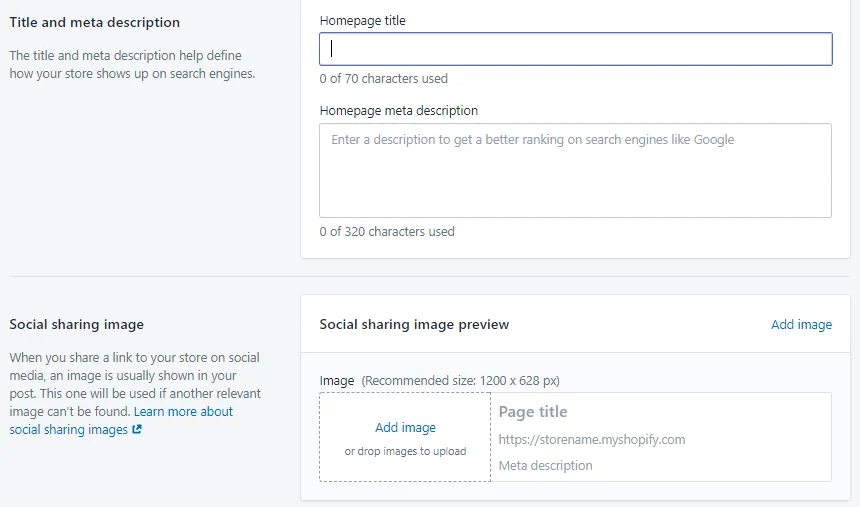
As seen from the image, adding a title, meta description, and images to your pages is easy and straightforward. Shopify also lets you create custom URLs and 301 redirects every time you change the URL so as to avoid 404 errors.
Having said that, there is still room for improvement. Certain URLs bear a mandatory string, which isn’t good for SEO. For example, product pages have ‘/products/’, and posts are stuck with ‘/posts/’ right after your domain name. Additionally, the Robots.txt file and Sitemap aren’t available for modification, making Shopify SEO a bit frustrating if you’re serious about site optimization.
Things aren’t that bad, though. Those were just some minor inconveniences that are outweighed by the number of benefits you can derive from Shopify. Don’t forget the huge app store with endless SEO possibilities and other tools to help you gain more traffic.
#2 Shopify marketing: User-friendly tools but lacks advanced segmentation (3.5 out of 5)
⭐ Our Rating: 3.5/5
When it comes to marketing features, we give Shopify a 3.5 out of 5. It covers the essentials with tools that are built right into the platform, but there are still limitations in terms of customization, advanced automation, and in-depth analytics.
💡 Our quick verdict
Shopify offers a solid foundation for basic marketing, but not much beyond that. The built-in tools make it easy to start sending emails, write blog posts, and recover abandoned carts. Still, the platform lacks depth in segmentation, analytics, and content marketing. It’s great for simple workflows, but power users will likely need more.
In this part of our Shopify review, we explore how well the platform handles key marketing functions, specifically blogging, email marketing, and abandoned cart recovery. These tools are essential for connecting with your audience and boosting sales over time, and Shopify includes them all without requiring extra apps.
First, Shopify does include a blogging feature, which is good news for store owners who want to publish content like updates, guides, or product stories. You can start posting right away from your admin panel, and it's easy to add tags, titles, and keywords for SEO.

That said, Shopify’s blogging tools are quite basic. You won’t find features like post categories, social bookmarking, or blog-specific analytics. If your business is content-heavy or blog-focused, platforms like WordPress or Wix offer much stronger tools. Shopify’s blog is best suited for product-first stores that only need light content marketing.
When it comes to email marketing, Shopify Email is a built-in tool that lets you create and send promotional emails without leaving your dashboard. You can choose from a set of customizable templates, edit them with your branding, and monitor performance using basic reporting features. Shopify allows you to send up to 10,000 free emails per month, which is a generous limit for small businesses. After that, extra emails are priced affordably.
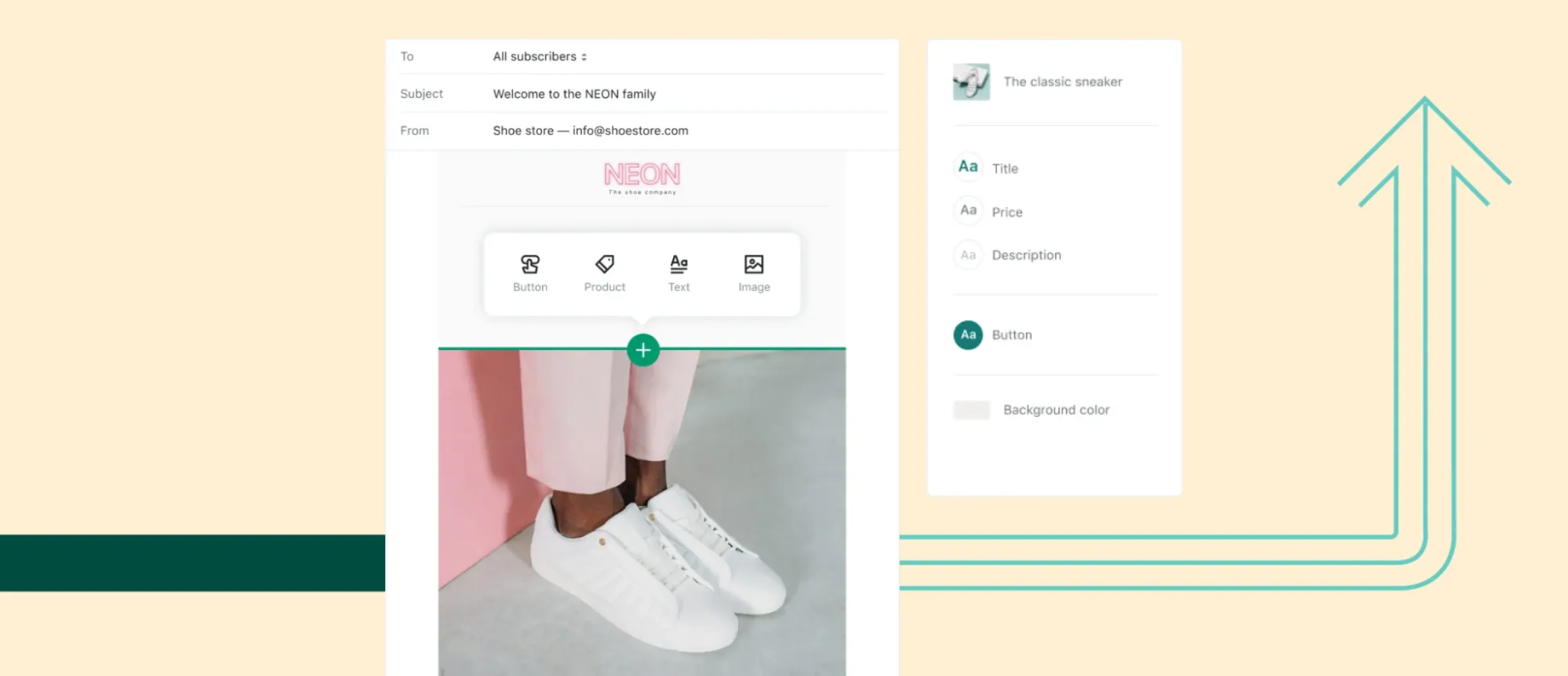
With that being said, while the tool is easy to use, it lacks advanced segmentation, multi-step automations, and dynamic content, which limits its usefulness for more advanced marketing teams.
Shopify performance: Fast and reliable for most stores (5 out of 5)
⭐ Our Rating: 3.5/5
We give Shopify a 5 out of 5 for performance because the platform consistently delivers fast loading times, stable uptime, and smooth user experiences—even under high traffic. Whether you're running a small store or scaling to thousands of customers, Shopify’s infrastructure is built to handle it.
💡 Our quick verdict
Shopify is one of the fastest and most reliable eCommerce platforms available in 2025. Page loads are quick, store uptime is excellent, and visitors enjoy smooth browsing, even during sales or seasonal traffic spikes. It’s performance you can count on, no matter your store size.
In this part of our Shopify review, we look at how the platform performs behind the scenes, and the results are impressive. Performance matters more than ever in eCommerce, as even a one-second delay in load time can impact conversion rates. Fortunately, Shopify offers a high-performance hosting environment that is both fast and reliable.
To start, all Shopify stores are hosted on a fully managed cloud infrastructure. This means you don’t need to worry about web hosting, security patches, or server maintenance. Shopify handles all of that in the background, so you can focus on growing your business.
One of the key reasons Shopify stores load so quickly is because of its global CDN (Content Delivery Network). This network ensures your site content, like images, product pages, and scripts, is delivered from the nearest server to your visitor’s location. As a result, your store loads faster for shoppers around the world.

In addition, Shopify includes performance features like automatic image optimization, lazy loading, and caching, all built in by default. You don’t need to install extra plugins or tweak settings to enjoy these benefits, they’re just part of the package.
Shopify security: Robust protection for your store (4 out of 5)
⭐ Our Rating: 4/5
In terms of security, we give Shopify a 4 out of 5 for security because it offers strong, built-in protection for both store owners and customers. For most businesses, Shopify’s security is more than sufficient, but advanced users may want greater visibility and customization.
💡 Our quick verdict
Shopify provides a secure and stable environment for running an online store. From SSL certificates to fraud detection tools, the platform covers all the essentials. While it's not perfect, especially when considering the security risks associated with external apps, it’s still a reliable and safe option for most e-commerce businesses.
When it comes to Shopify's security, apparently, there's less to worry about when you opt for a hosted eCommerce solution instead of building a store with open-source platforms. Therefore, you don’t even need to do anything – Shopify takes care of all tasks regarding security in the background.
With SSL Certificates for every Shopify site, all data transferred between you and your customers is encrypted. This helps increase trustworthiness as sensitive information, such as credit card details, is entirely secure. Additionally, Shopify is also PCI compliant, meaning it follows security standards for processing credit card and debit card details. Besides, this platform also enables users to use the Shopify cookie policy generator on their sites.
In short, it's quite clear that Shopify meets top standards for secure data processing, so there's nothing for both you and your customers to worry about. For added peace of mind, there's even a cookies policy generator that helps your store stay compliant with ease.
Shopify support: Not the most responsive platform (3 out of 5)
⭐ Our Rating: 4/5
Shopify earns a 3 out of 5 in support due to the inconsistent response quality and speed. Shopify does provide multiple support channels, including live chat, email, and community forums, but users often report long wait times, repetitive responses, and limited technical depth from frontline agents.
💡 Our quick verdict
Shopify support is always available, but not always helpful. You can contact an agent at any time, but getting a fast or detailed answer often depends on the issue, and your luck. For small problems, support usually works fine. For technical or urgent issues, the process can be slow or frustrating.
In this part of our Shopify review, we examine the platform’s customer support experience. While Shopify has grown into one of the biggest eCommerce platforms in the world, its customer support hasn’t always kept up with the expectations of its user base.

The good news is that Shopify offers 24/7 support, which is available through live chat, email, and a robust help center. If you're facing a basic issue, like setting up products, configuring shipping, or managing payments, you’ll usually get the help you need. The support team can walk you through simple problems, send help articles, or escalate issues when necessary.
Shopify also has an active community forum where users and developers help each other. You’ll find discussions, tutorials, and shared experiences that can be helpful if you prefer to troubleshoot on your own.
However, many users have noted that the response time can be slow, especially during peak hours. In some cases, the live chat agents take a long time to respond or hand off the issue without resolving it. For technical problems, you may be referred to Shopify’s developer documentation or told to contact the theme or app developer directly, which can feel frustrating if you expected a more hands-on approach.
Our Methodology: How We Write This Shopify Review
At the core of every great review is a clear, honest process, and that’s exactly how we approached this Shopify review. Our goal is to give you practical, unbiased insights that reflect how the platform actually performs in real-world scenarios. Here’s how we evaluate each section of the review and arrive at our ratings:
1. Hands-on testing
We don’t just rely on marketing claims, we test Shopify ourselves. We create demo stores, explore setup steps, and use built-in features like Shopify Markets, Shopify Email, and the POS system. We look closely at speed, usability, SEO settings, checkout flows, and app integration to see how everything performs for a real store owner.
2. Feature-by-feature evaluation
Each part of Shopify is scored independently, such as pricing, ease of use, eCommerce tools, SEO, and customer support. For each category, we consider:
- How complete the feature is (Does it do what sellers need?)
- How easy it is to use (Can beginners and non-coders handle it?)
- How well it performs (Is it fast, reliable, and scalable?)
- How it compares to similar platforms (Is it competitive?)
3. Real user feedback
We research what actual Shopify users are saying on platforms like Trustpilot, Reddit, and eCommerce forums. This helps us understand recurring pain points and praises from business owners across different industries and experience levels. We include direct quotes where possible to highlight real-world feedback.
4. Independent & transparent opinions
We are not paid by Shopify to write this review. We aim to help you decide if Shopify is the right choice for your business, based on facts, not hype.
Shopify Review – FAQs
Is Shopify safe to buy from?
Absolutely yes. It's totally safe to buy from online stores hosted by Shopify.
Can you really make money with Shopify?
In some cases, making money on Shopify doesn't even require you to sell anything at all. For instance, the Shopify affiliate marketing program lets you earn money per successful referral made from your account to the Shopify platform.
Is Shopify profitable?
Shopify is packed with lots of eCommerce features yet it is fairly easy to use. It is suitable for any eCommerce user regardless of their technical background. However, a downside of Shopify is the high transaction fees it charges for every purchase.
What are the best Shopify alternatives?
Magento, BigCommerce, or PrestaShop, can be great solutions for Shopify alternatives.
Is Shopify good for beginners? Is Shopify worth it for a small business?
As you can see from our Shopify review, Shopify is a dynamic all-in-one solution to host and manage an online store that doesn’t take much muscle and technical expertise. Thus, it’s ideal for newbies and amateur users. So, is Shopify easy to use? The answer is yes!
Is Shopify legit?
Yes, it is. Selling on Shopify is a legitimate and profitable business.
Does Shopify take a percentage of sales?
The bad news is that you cannot receive full revenue on this platform. Shopify does take a small percentage of sales in the form of transaction fees. This additional charge is taken based on your Shopify pricing plan.
Please navigate to the pricing section of our Shopify review or take a look at our detailed Shopify pricing breakdown for more information about this fee.
⚖️ Shopify Review – Let's Wrap Things Up!
And that brings us to the end of our Shopify review.
Overall, in this review article, we have clarified all Shopify pros and cons, Shopify new features 2025, and is selling on Shopify worth it. Hopefully, this article has successfully cleared all your doubts about Shopify – an eCommerce giant, an excellent alternative to other big names like BigCommerce, WooCommerce, or Magento.
LitExtension – #1 Shopping Cart Migration Expert suggests using Shopify to create your eCommerce website as it's a highly flexible platform with a large app store, reasonable pricing plans, and an impressive range of built-in features.
📌 Furthermore, Shopify has great sales potential, ease of use, and satisfaction rates, making it an excellent option for newcomers and big sellers. According to our recent data report, our customers have been flocking to Shopify because of outstanding Shopify features, and we have also received positive feedback on this platform.
If you're planning to move to Shopify, don’t miss out on our Shopify migration services. LitExtension provides a seamless and secure migration process to Shopify from platforms like WooCommerce, Magento, OpenCart, and more -with no data loss or downtime.
For more Shopify tips and news, please visit our Shopify articles and join our Facebook Community.
